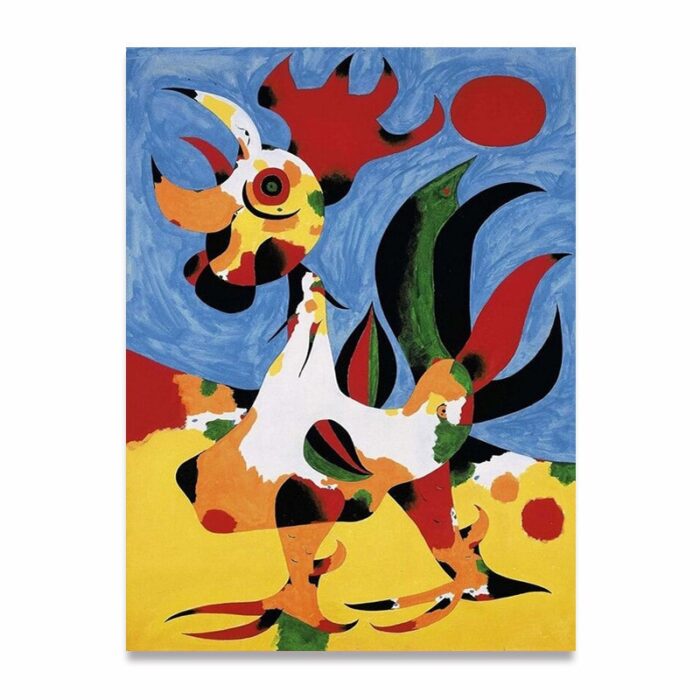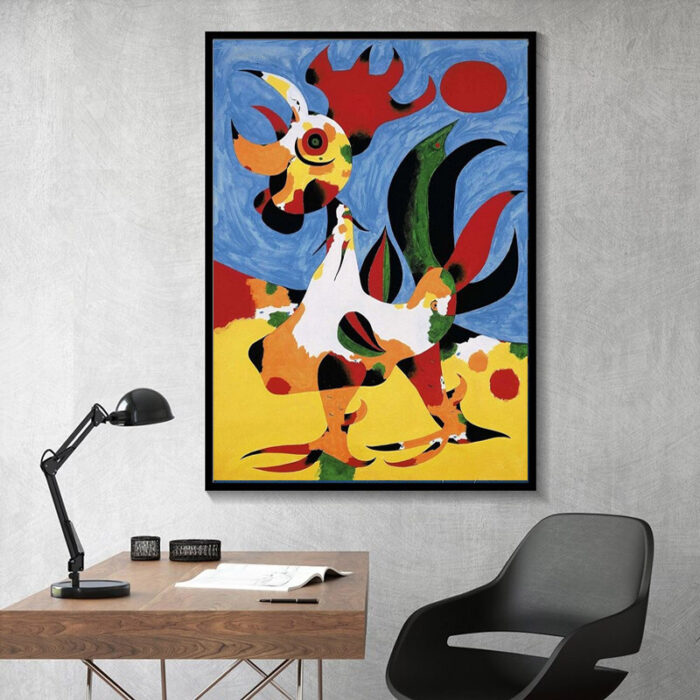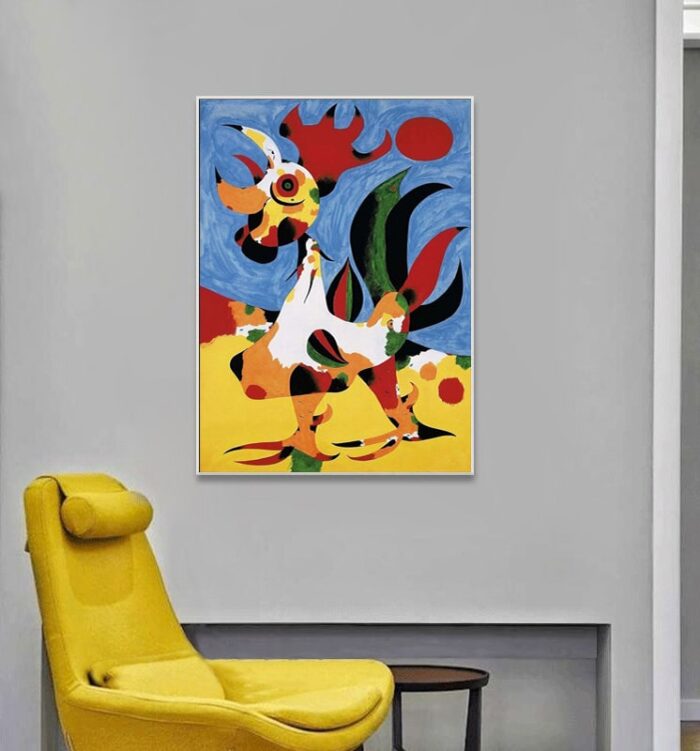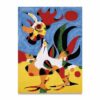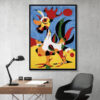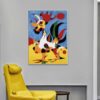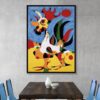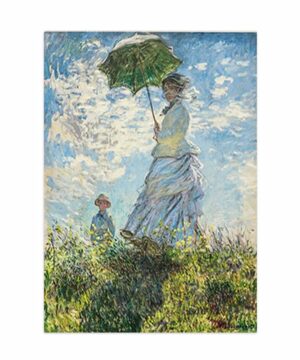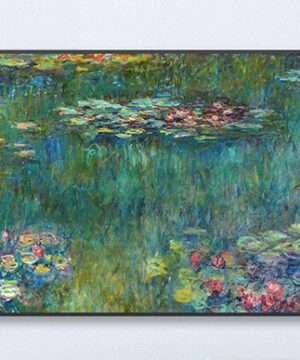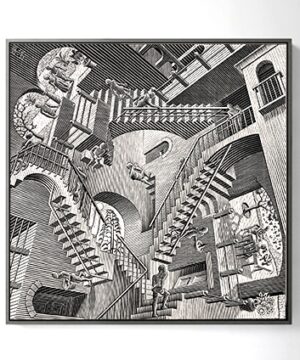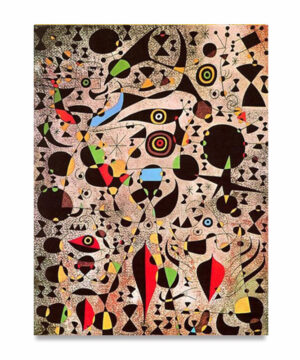Joan Miró combined abstraction with surrealist fantasy. Evident in his work “Le Coq” (“The Rooster”) created in 1939, his mature style makes use of the tension between poetic impulse and the unpleasant realities of modern life. Even though his work is loved for its joyful celebration of colour, it also contains messages about emotional agony and despair about war and destruction, as well as ideas about peace and freedom.
Miró sought to portray nature as it would be depicted by a child, using simplifications, however with the knowledge, irony, and rational abilities of an adult. The poetic nature of Miró’s artworks fits well within the dream-like automatism of the surrealist art group. Although he is widely considered a leading artist of SurrealismSurrealism was a 20th-century philosophical, literary, and artistic movement seeking to channel the unconscious to access the imaginary. Proponents of Surrealism rejected the notion of understanding life in rational and conventional terms in favour of asserting the value of the unconscious mind, dreams, the strangely beautiful, and the uncanny. André Breton, the leader of a group of poets and artists More, he refused to be officially part of the group to be able to explore other styles more freely.
Where is the picture “Le Coq” today?
The original of “Le Coq” by Joan MiróSpanish Catalan artist Joan Miró (1893 – 1983) is famous for his works in painting, sculpture, and ceramics. His work is strongly influenced by his hometown Barcelona, the scenic seaside, and the distinct style of that area. From early on, he was exposed to the arts through his parents’ professions: His mother was a goldsmith, father worked as a watchmaker. More was sold at the auction house Christie’s London in 2007 and is currently part of a private collection.
What’s in it?
In Le Coq, Joan MiróSpanish Catalan artist Joan Miró (1893 – 1983) is famous for his works in painting, sculpture, and ceramics. His work is strongly influenced by his hometown Barcelona, the scenic seaside, and the distinct style of that area. From early on, he was exposed to the arts through his parents’ professions: His mother was a goldsmith, father worked as a watchmaker. More uses a limited, but intense palette of colours to depict a rooster in front of a landscape, using gouache and watercolour in combination with pencil drawing. The rooster completely dominates the composition, his head tilted backwards, and his sharp beak opened as if giving a defiant scream. This piercing notion is emphasized by the contrast of colours. Searing reds vibrate alongside grass green. The saturated yellow earth hits the azure blue sky – which is more evocative of Mont-Roig, where Miró’s family had a summer house than of the Normandy coast. Interspersed black elements emphasize the sharpness of the beak and the claws, heighten the variegation of the white plumage, and push the contrasts to a new level.
What’s the context?
Joan MiróSpanish Catalan artist Joan Miró (1893 – 1983) is famous for his works in painting, sculpture, and ceramics. His work is strongly influenced by his hometown Barcelona, the scenic seaside, and the distinct style of that area. From early on, he was exposed to the arts through his parents’ professions: His mother was a goldsmith, father worked as a watchmaker. More neither positioned himself as an explicitly political artist nor did he work exclusively formalistically with pure colours and forms, turning a blind eye to developments in society. He considered himself a man of freedom and liberalism. However, the movement for Catalan independence, the Civil War, the Franco dictatorship, as well as the Second World War strongly influenced his work.
Joan Miró’s “Le Coq” was painted in a village on the Normandy coast called Varengeville-sur-Mer, where he and his family sought refuge from 1939 to 1940 at the beginning of the Second World War. The artist commented: “At Varengeville-sur-Mer, in 1939, began a new stage in my work which had its sources in music and nature. It was about the time that the war broke out. I felt a deep desire to escape. I closed myself within myself purposely.”
Chatter and Prattle
Joan MiróSpanish Catalan artist Joan Miró (1893 – 1983) is famous for his works in painting, sculpture, and ceramics. His work is strongly influenced by his hometown Barcelona, the scenic seaside, and the distinct style of that area. From early on, he was exposed to the arts through his parents’ professions: His mother was a goldsmith, father worked as a watchmaker. More, “Le Coq” – Facts:
- Miró’s instinct for political engagement was heartfelt, full of fear of risk and danger. He would often react through gestures of withdrawal and self-defence. André BretonAndré Breton (1896 – 1966) was a French writer and poet, best known as an original member of the Dada group and one of the founders of the Surrealism movement. His seminal writings include the first Surrealist Manifesto (Manifeste du surréalisme), published 1924, in which he defined surrealism as "pure psychic automatism", encouraging chance and spontaneity in artistic practices. Breton More, the founder of the surrealist movement, once referred to Miró, as a case of “arrested development” and as a childlike artist – a label, that would stick with Miró for a long time.
- In June 2007, Joan Miró’s “Le Coq” sold for £6.6m at the auction house Christie’s London, against a pre-sale high-end estimate of £4.5m. It had previously sold at Christie’s for £1.7m in June 2003.
Do you want to comment on this text on Miro’s Le Coq or add information? We would like to hear from you.
Recommended Readings:
This article may contain compensated links. Please read Disclaimer for more info. As an Amazon Associate, I earn from qualifying purchases.
Joan Miro et al. (2017): Joan Miro: I Work Like a Gardener (Interview with Joan Miro on his creative process)
Carolyn Lanchner (1993): Joan Miro (A Museum of Modern Art Book)
Agnes De La Beaumelle (2020): Joan Miró 1917–1934: I’m Going to Smash their Guitar
Margit Rowell et al. (2017): Miro and Calder’s Constellations
Marko Daniel et al. (2012): Joan Miro: The Ladder of Escape

